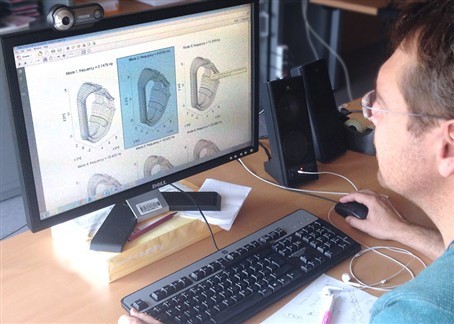New numerical model facilitates calculations for vacuum vessel electromagnetic loads


Imagine a force equivalent to the weight of the entire Eiffel Tower confined in one metallic doughnut-shaped container in the heart of the ITER machine (the vacuum vessel) – this is basically what will happen when the plasma with light atomic nuclei that fuse together to form heavier ones and thus produce fusion energy, becomes instable.
Producing fusion is a very difficult process to recreate on earth – gases need to be heated to extremely high temperatures (about 100 million° C) to produce a plasma which then needs to be contained for a sufficiently long period for fusion to occur. To reach these temperatures there must first be powerful heating, and thermal losses must be minimised by keeping the hot fuel particles away from the walls of the vacuum vessel. This is achieved by creating a magnetic “cage” made by strong magnetic fields, which prevent the particles from escaping and thus keeping the plasma “stable”. An instable plasma (i.e. uncontained and moving around) will result in electromagnetic forces in the magnitude of 100 MN (equivalent to the weight of the Eiffel Tower) created by electrical currents interacting with the magnetic fields (electromagnetic loads)produced by the set of superconducting coils which are necessary to keep the plasma in place in the vacuum vessel.
F4E has collaborated with Guglielmo Rubinacci, an external expert from the University of Naples Federico II, in order to develop a mathematical model in a computer programme which will simulate the behaviour of the ITER vacuum vessel, during the fusion process when it is under the effect of the electromagnetic loads. It is the first time such tool has been developed and the objective is to check and test how the vacuum vessel, or also other components, of ITER will deform during the operation of the ITER machine.
Previously, other numerical models (which for example are used in the engineering simulation software ANSYS) have been used for such kind of analysis. F4E’s collaboration with the University of Naples has however focused on improving the already existing numerical analysis by increasing the information available from the simulations. It is now possible to obtain the full history of the deformation of the vacuum vessel, including the magnetic damping (this means having more accurate information about the movement of the vacuum vessel during the plasma instability). This further developed numerical model allows for a better evaluation of the mechanical behaviour of the ITER vacuum vessel.
“The numerical procedures carrying out the calculations is extensively tested and validated against available experimental results”, explains Pietro Testoni, Technical Officer responsible for F4E’s work in this area. “We have actually managed to calculate more accurately than was originally foreseen and this allows us to fine-tune the design of the supporting structure of the vacuum vessel and improve the safety margin during the operation of the machine”, he adds.
The application of this numerical model to the analysis of the ITER vacuum vessel received a great deal of praise when it was presented to the scientific fusion community during the ISFNT conference held in the South Korean Jeju Island in September. As well as facilitating the work with ITER, this numerical model will be also used in the work of developing the next generation fusion machines, such as DEMO.